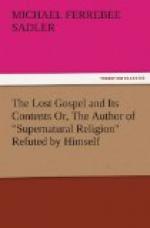Well, then, the reader will ask, from whom did Justin derive the knowledge of doctrines and facts so closely resembling those contained in St. John?
Again, we have reference to supposed older sources of information which have perished. With respect to the Logos doctrine, the author of “Supernatural Religion” asserts:—
“His [Justin’s] doctrine of the Logos is precisely that of Philo, and of writings long antecedent to the fourth Gospel, and there can be no doubt, we think, that it was derived from them.” ("Supernatural Religion,” vol. ii. p. 297.)
It may be well here to remark that, strictly speaking, there is no Logos doctrine in St. John’s Gospel,—by doctrine meaning “scientifically expressed doctrine,” drawn out, and expounded at length, as in Philo. The Gospel commences with the assertion that the Logos, Whoever He be, is God, and is the pre-existent Divine nature of Jesus; he does this once and once only, and never recurs to it afterwards.
The next passage referred to is the assertion of the Baptist, “I am not the Christ,” and the conclusion of the author is that “There is every reason to believe that he derived it from a particular Gospel, in all probability the Gospel according to the Hebrews, different from ours.” (Vol. ii. p. 302.)
The last place noticed is Justin’s reproduction of John iii. 3-5, in connection with the institution of baptism. After discussing this at some length, for the purpose of magnifying the differences and minimizing the resemblances, his conclusion is:—
“As both the Clementines and Justin made use of the Gospel according to Hebrews, the most competent critics have, with reason, adopted the conclusion that the passage we are discussing was derived from that Gospel; at any rate it cannot for a moment he maintained as a quotation from our fourth Gospel, and it is of no value as evidence for its existence.” ("Supernatural Religion,” vol. ii. p. 313.)
We have now tolerably full means of judging what a wonderful Gospel this Gospel to the Hebrews must have been, and what a loss the Church has sustained by its extinction.
Here was a Gospel which contained a harmony of the history, moral teaching, and doctrine of all the four. As we have seen, it contained an account of the miraculous Birth and Infancy, embodying in one narrative the facts contained in the first and third Gospels. It contained a narrative of the events preceding and attending our Lord’s Death, far fuller and more complete than that of any single Gospel in the Canon. It contained a record of the teaching of Christ, similar to our present Sermon on the Mount, embodying the teaching scattered up and down in all parts of SS. Matthew and Luke, and in addition to all this it embodied the very peculiar tradition, both in respect of doctrine and of history, of the fourth Gospel.




